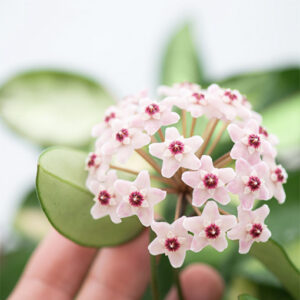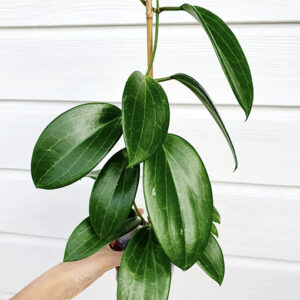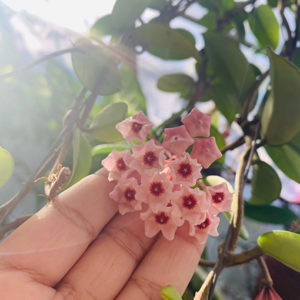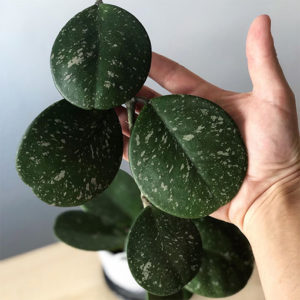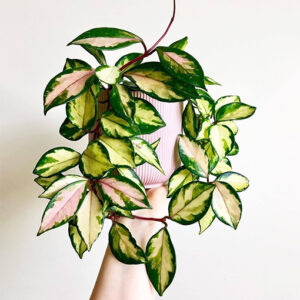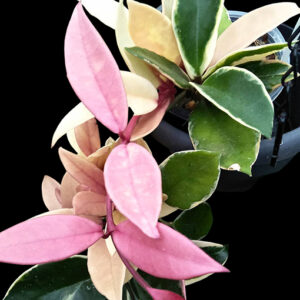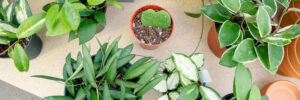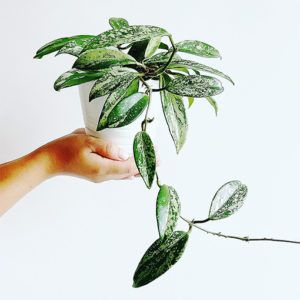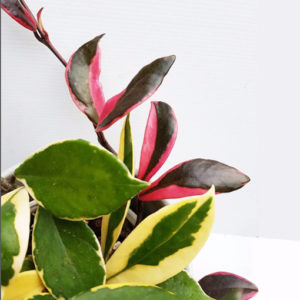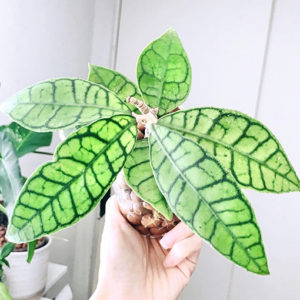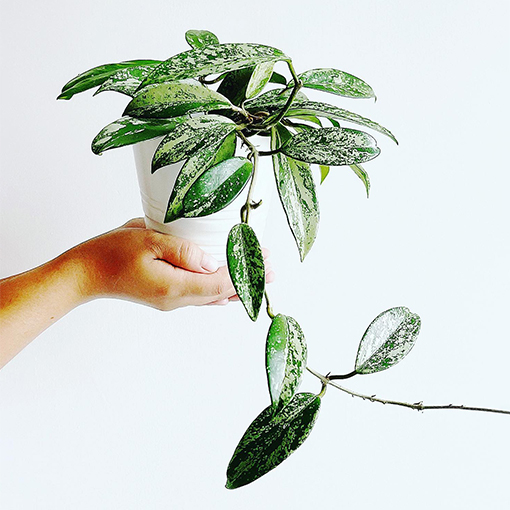
It’s hard to beat the silver splattered variegation of the Hoya Pubicalyxs deep green elliptical leaves. Well, that is until it goes into bloom with its stunning wax flower stars. A low-care gem that can handle lower light conditions, whilst being pet-friendly, what more could you ask for!
📷: @hoya.blues
Where to buy a Hoya Pubicalyx Plant in Australia?
Why we’re glad you asked as we do our best to have a steady supply of Hoya Pubicalyx plants.
Hoya Pubicalyx Plant Introduction
No doubt, Hoya pubicalyx is a popular plants famous for both its wax flowers and stunning foliage and it is the perfect addition to every home, office or greenhouse. This easy-to-grow vine belongs to the Apocynaceae family and has gorgeous, star-shaped fragrant flower that can bloom from late Spring to late Summer. Whilst its wax flowers are a great showpiece it also has stunning foliage with thick deep green elliptical leaves with silver speckles. The most well-known varieties of the Hoya Pubicalyx include Royal Hawaiian Hoya, Pink Silver, Red Buttons and Black Dragon and its wax flowers can range from pink to burgundy through to dark purple/grey.. Even though this is a low-maintenance and very popular vine, it is good to know a few tips about how to make it thrive. Continue reading and we will help you learn all you need to know about how to grow a beautiful and healthy Hoya!
Hoya Pubicalyx Lighting & Position
It is best to place your Hoya plant in a bright area where it receives indirect sunlight for at least 6 hours a day. If it does not get enough light, its growth will be slower and potentially more leggy. But if you put it in a place that receives too much direct and harmful rays, it is possible that the leaves will turn red and dry out. This is a sign that they are burned and you should move the plant to a more protected location. A fascinating fact is that Hoya pubicalyx produces a natural pigment called Anthocyanin, which protects the young or soft leaves from too much light. Indeed, the mature leaves have a silver-pink hue when exposed to more sunlight and you will have a pink Hoya to adorn your home.
Hoya Pubicalyx Watering
Fortunately, Hoya pubicalyx has a drought-tolerant foliage which means that it is relatively simple to water. During the growing season, you can water it on a regular basis. It is beneficial to monitor the moisture level and water when the top two inches of soil are dry. In Summer and during particular hot spells, we recommend that you water your houseplant up to three times a week.
During Autumn and Winter, watering should become less frequent. Consider the temperature and light conditions as well, as they have an impact on the watering schedule. If you grow it in a peaty mix, water it less frequently because it will retain water.
If you chose to put it in a lighter potting mix, water it thoroughly until you see water pouring from the bottom. However, do not let your Hoya pubicalyx sit in water for a long period of time and avoid soggy soil. One sign that you may be overwatering your plant is if it begins to shed leaves.
Hoya Pubicalyx Humidity
As it originates from the Philippines, this tropical plant prefers high humidity levels and will do best in 60% to 70% humidity indoors or outdoors although it is tolerant to drier conditions. If you live in a dry area, your Hoya will appreciate it if you keep it close to a humidifier or if you mist it with water. However, it is not recommended to shower your plant when it begins to bloom. It also helps to keep your Hoya away from any AC, vents, or heaters to keep the foliage from drying out.
Hoya Pubicalyx Soil and Fertiliser
The Hoya Pubicalyx will thrive best in well-draining loamy potting mix with a Neutral to slightly acidic PH (6.5-7.5).
Your Hoya does not need much feeding, but it does benefit from some extra nourishment throughout the growing season. We recommend applying a potassium-rich liquid fertilizer. Before applying it to the plant, dilute it by half. Foliar fertiliser can also be used.
Another excellent fertiliser is monthly application of compost tea or diluted fish emulsion. Still, avoid feeding your plant throughout the Winter since it goes into semi-dormancy. To avoid root burn, make sure the soil mixture is moist before feeding. We recommend using our Plant food available here.
Hoya Pubicalyx Extra Tips
One of the most fascinating things about Hoya Pubicalyx flowers is their ability to climb and vine. If you want to try it and make your Hoya even more beautiful you can easily train it. To start training your Hoya Pubicalyx to vine, simply wrap a few vines around whatever you want them to trail on. The plant will then begin “grabbing” and winding around the existing vines. It’s quite simple to train.
Hoya Pubicalyx Vulnerability to Pests & Disease
While this exotic plant is a low-maintenance plant, pests can still be a threat, especially if the plant is in sad conditions and its natural defence is weakened. The most detrimental insect you can face is Root-rot Nematode, which is often caused by over-watering. Signs of an infestation with this insect are yellowing, wilting leaves, and stunted growth. If your plant is infected remove from its pot, remove all soil, cut back affected roots, dip the roots in a fungicide, replant in a new pot with new soil. Cut back its foliage to reduce the stress and allow to recover more quickly. Another common insect that your Hoyas can suffer from are the mealybug. They can be treated with insecticides in the soil or spot treatment with isopropyl alcohol. If you notice bugs on the back of the Hoya pubicalyx’s leaves outside, they are most likely aphids. During the warmer months, Whiteflies can cause the leaves to yellow and dry out. Yellow sticky traps can be used to deal with them and keep them from infesting your favourite plant. Pro Tip: If your Hoya is infested, you can effectively treat it with neem oil or horticultural oil. For more information on how to manage common plant pests head to our blog here.
Hoya Pubicalyx Toxicity to Pets
The Hoya Pubicalyx is non toxic meaning it is safe for dogs, cats and children.
How to Propagate Your Hoya Pubicalyx
If you want to propagate your Hoyas, we suggest that you to do it in the Spring and Summer months which will give them the best chance of rooting. To propagate your hoya you can use stem cuttings. Here are 5 steps you can easily follow:
1. Make a 5-inch (125mm) cutting with at least three nodes (where leaves connect to the stem).
2. Remove any leaves from the lower end.
3. Dip the cutting tip in a hormone mix and plant the cutting with nodes about 4 inches (100mm) deep in a pot with fresh soil.
4. Keep the pot in a warm, humid location away from direct sunlight.
5. Water the soil at least three times every week to keep it moist. Roots will form in approximately a month and it will be ready to be repotted.
Hoya Pubicalyx Design Tips
The deep green and silver speckled leaves of the Hoya Pubicalyx work well against light, rustic terracotta or soft pink or orange pots. They are great both as trailing hanging baskets or as trained climbers. They look terrific against gold wire trellis.

